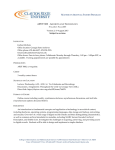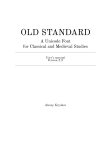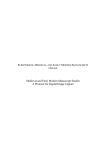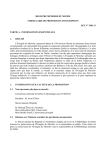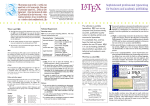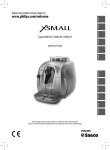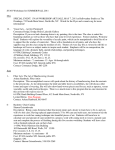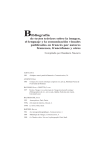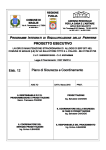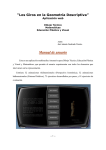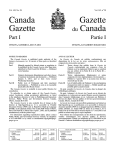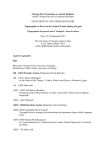Download GREEK PALEOGRAPHY (Fonts for ancient Greek)
Transcript
FONTS FOR GREEK PALEOGRAPHY ANGULAR UNCIAL, BIBLICAL UNCIAL, COPTIC UNCIAL, PAPYRUS UNCIAL, ROUND UNCIAL, SLAVONIC UNCIAL, SLOPING UNCIAL, MINUSCULE IX, MINUSCULE XI and MINUSCULE XV User’s manual 2nd edition January 2014 Juan-José Marcos [email protected] Professor of Classics. Plasencia. (Cáceres). Spain. Designer of fonts for ancient scripts and linguistics ALPHABETUM Unicode font http://guindo.pntic.mec.es/jmag0042/alphabet.html PALEOGRAPHIC LATIN fonts http://guindo.pntic.mec.es/jmag0042/palefont.html PALEOGRAPHIC GREEK fonts http://guindo.pntic.mec.es/jmag0042/palegreek.html TABLE OF CONTENTS Page INTRODUCTION: FONTS FOR GREEK PALEOGRAPHY Font package for Greek Paleography Characteristics of the fonts Price of the palaeographic set of fonts Methods of payment Suggestions and queries 3 5 6 6 6 FIRST PART: A BRIEF OVERVIEW ON GREEK PALEOGRAPHY Preliminary advice Styles of Greek handwriting The papyrus period (Uncials) • Ptolemaic period • Roman period • Byzantine period The vellum period (Uncials) • Biblical Uncial • Sloping Uncial • Coptic Uncial • Slavonic Uncial The minuscule handwriting (Minuscules) • Codices Vetustissimi • Codices Vetusti • Codices Recentiores • Codices Novelli Unicode-encoded fonts Private Use Areas OpenType • Introduction • Mac and PC compatible • What is inside? • How to enable OpenType features in applications • OpenType features in Microsoft Word • OpenType features in Adobe InDesign • OpenType features in QuarkXPress 2 (7-60) 8 8 10 11 15 19 22 23 31 33 36 39 42 46 49 53 SECOND PART: TECHNICAL INFORMATION Paleographic fonts for Greek script (3-6) (61-71) 62 63 64 64 64 65 66 67 68 70 Juan-José Marcos [email protected] FONT PACKAGE FOR GREEK PALEOGRAPHY The font package termed "Fonts for Greek Paleography" is a font package which contains a total of 10 typefaces named ANGULAR UNCIAL, BIBLICAL UNCIAL, SLOPING UNCIAL, COPTIC UNCIAL, PAPYRUS UNCIAL, ROUND UNCIAL, SLAVONIC UNCIAL, MINUSCULE IX, MINUSCULE XI and MINUSCULE XV respectively. As their names denote, these fonts are representative of the main styles of Greek handwritings used during ancient times and Middle Ages. These fonts belong to the category known as facsimile level and they are intended to resemble the handwriting style of Medieval Greek scripts as appear in manuscripts. The paleographic font package is a collection of fonts based on ancient and medieval calligraphy which include specialty characters, abbreviations, ligatures and alternate forms for some letters. These paleographic fonts can be used to represent medieval manuscripts in a "semi-diplomatic" fashion. That is, an edited version of the manuscript that preserves more features of the original document than is common in standard, normalized, modern editions. They allow the preservation of many medieval features, and can be used to help students become more familiar with medieval writing and languages without the expense of purchasing semi-diplomatic editions or facsimiles of manuscripts. This collection of fonts is suitable for students and scholars of historical sciences as well as desktop paleographical publishing. It may be of interest to students and professionals dealing with paleography, linguistics and classical and medieval Greek. Doubtless this is the most authentic and useful of font packages currently available to medievalists. As mentioned above, these fonts are based on medieval and ancient Greek lettering styles. For this reason they may not include all the characters you may expect and, in contrast, may include specialty characters (nomina sacra, ligatures etc) or strange alternate forms for some letters. You can access those special characters present in the fonts through programs which support OpenType features (Word 2010-2013, InDesign, QuarkXpress, Mellel, Illustrator, TextEdit, Nisus Writer etc.) or by using a character map (or even with the clumsy method of Insert/Symbol command) since they have been assigned code points in the so-called Private Use Area of Unicode. Please read the following pages for further details about signs present in the fonts and OpenType issues. --------------------------------------------------------------------------------------------------------The paleographic Greek fonts collection consists of 10 typefaces (Angular Uncial, Round Uncial, Papyrus Uncial, Biblical Uncial, Sloping Uncial, Coptic Uncial, Slavonic Uncial, Minuscule IX, Minuscule XI and Minuscule XV) closely based on historical models with the right virtues of the original being kept in focus, all with a solid grounding in type scholarship behind the effort, too. Paleographic fonts for Greek script 3 Juan-José Marcos [email protected] A)= Typefaces included in the Uncial class use as a source of their design the different Greek handwriting hands used from around the first century B.C. till the tenth century A.D. approximately. Here is a brief description of the different typefaces: 1.- Handwriting on papyrus. ANGULAR UNCIAL is a digital replica of the handwriting employed in the Bacchylides papyrus, now preserved in the British Museum. The only evidence as to the age of the manuscript is that afforded by the handwriting. Guided by this Dr Kenyon assigns the Bacchylides papyrus to the first century B.C. ROUND UNCIAL is a close resemblance to the hand used in the so-named Hawara Homer, a papyrus (now in the Bodleian Library in Oxford) from the second century A.D. containing portions of the second book of the Homer’s Iliad. PAPYRUS UNCIAL closely follows the so-called P66 which is a near complete codex of the Gospel of John and part of the collection known as the "Bodmer Papyri". It is one of the oldest New Testament manuscripts known to exist, with its writing dated to around 200 A.D. 2.- Handwriting on parchment or vellum. BIBLICAL UNCIAL mimics the hand of the Codex Bezae Cantabrigiensis, a Greek and Latin diglot, which contains the four gospels and the Acts of the Apostles. Following Scrivener, scholars universally dated it from the beginning of the sixth century A.D., but there is a tendency now to place it a hundred years earlier. The Cambridge University Library holds the manuscript. SLOPING UNCIAL is based on the lettering showed in the Codex Washingtonianus, also called The Freer Gospel, which contains the four biblical gospels and was written on vellum in the 4th or 5th century A.D. COPTIC UNCIAL reproduces the style of handwriting known as "Coptic", which was used for Greek in some manuscripts such as the Codex Marchalianus (written in Egypt around the sixth century A.D.) or the Codex Vaticanus Borgianus (sixth century A.D.), for example. SLAVONIC UNCIAL, as its name denotes, imitates the style of handwriting known as "Slavonic", (since the Slavs took most of their alphabet from it). This style represents the late and final development of the Uncial Greek handwriting and was employed in manuscripts like the Codex Boreelianus (ninth century A.D.). Paleographic fonts for Greek script 4 Juan-José Marcos [email protected] 2)= Typefaces included in the Minuscule class (MINUSCULE-IX, MINUSCULE-XI and MINUSCULE-XV) imitate the ordinary style of the Byzantine manuscripts, being closer imitations of the different Greek minuscule handwritings used from the ninth to the fifteenth century. These fonts contain the most common ligatures. The most convenient way to access them is via OpenType features. Read pages 61-71 for further details. IMPORTANT THINGS TO NOTE: 1.- All the fonts are accompanied by their Roman counterpart matching the Greek face as best as possible. See images below. 2.- The fonts are edit-embeddable to permit the creation of Adobe Acrobat documents (PDF) and web pages with embedded fonts (the so-called "web-fonts": EOT, WOFF and SVG formats). 3.- The digital typefaces may be purchased individually or all together. CHARACTERISTICS OF THE FONTS The paleographic fonts collection for Greek is a series of fonts covering a number of codices and papyri from different ages. The fonts are provided in Unicode-encoded TrueType or OpenType format. The Windows and Mac versions of the fonts are cross-platform compatible. Therefore they permit direct exchange of all their standard Unicode-encoded characters with any other Unicode font containing those characters on either platform. The paleographic font package contains the letters, breathing marks, accents and other special characters necessary to reproduce the standard character form text of codices and papyri. Please note that most of the ancient codices or papyri do not show (display) diacritics at all or seldom rarely, however, because many users may want to type the original hand, but also display the breathing marks and accents, the fonts include these diacritical marks. Another useful feature is the inclusion of nomina sacra, since the fonts contain extendible overstriking bars for creating titles and abbreviations occurring in most manuscripts. Hence with these fonts you can type faithful representations of the original hand of important early codices or papyri with Unicode-encoded Greek fonts. By using these fonts you can type text just as it was originally copied by its scribe. The following pages show text samples written with these fonts. Paleographic fonts for Greek script 5 Juan-José Marcos [email protected] PRICE OF THE PALEOGRAPHIC SET OF FONTS These fonts based on historical prototypes are the result of long hours of investigation and hard work. Font development is a painstaking, time-consuming task and this is a single person's work not sponsored by any institution. Hence these fonts are not free. Nevertheless, the font package has a reasonable price. Registration costs US $135, £84 or €100 * (see advise below) If you wish, you also can purchase only one individual font. Each single font costs US $27, £17 or €20. SPECIAL PRICING: Pay two fonts and get three. Purchase three fonts for €40 or $56. If you acquire two fonts, the third is for free. A 33% discount! Five fonts for €60 or $84. A 45% discount! After making the payment you will receive the fonts as attachment to an email message sent to your email account. If you wish to receive the fonts in a CDRom sent by post to your address, the extra cost is $20, £12 or €15. The CDRom contains the set of paleographic fonts plus other additional free programs (an excellent free word processor for Windows, font utilities, character maps, a generator of PDF files which runs under Word for Windows etc) which will allow you to manage properly these fonts. *ADVISE: Due to the current fluctuation in the exchange rate among different currencies, only prices in Euro can be guaranteed. The prices in US$ depend on the actual exchange rate (at the date of this writing, January 2014, 1 euro is equivalent to 1,35 US dollars). METHODS OF PAYMENT If you own a credit or debit card (Visa®, MasterCard®, Discover® and American Express®), you can pay online, which means purchase can be made in a matter of clicks. This payment is being backed by PayPal®, a global leader in online payment solutions. To make payments with PayPal is easy, fast, free and secure for buyers. Naturally, your transaction will be confidential and the information you give will not be used for any reason other than the use intended. PayPal protects your security. Visit my page for further details: http://guindo.pntic.mec.es/jmag0042/palegreek.html For other alternative methods of payment (bank transfer, postal order etc), please email me for more information. SUGGESTIONS AND QUERIES I have taken care to see that these fonts work as well as possible, nevertheless, if you find any fault, feel free to email me. Although you do not purchase the fonts, please, send me comments, suggestions for improvements or anything else regarding my paleographic fonts. I would like to know your opinion about my work. I really would appreciate having users' feedback. Such reaction from users will be the deciding factor in my decision of carrying on with the development of more paleographic fonts. Do not hesitate to email me [email protected] Your comments will be welcome. Thanks in advance. If this set of fonts is well received, it will be expanded with new additions in the near future. A similar font package for Latin Paleography is also available. http://guindo.pntic.mec.es/jmag0042/palefont.html Juan-José Marcos García. [email protected] Head of Department of Classical Languages Plasencia. Spain. 9 January 2014. Paleographic fonts for Greek script 6 Juan-José Marcos [email protected] FIRST PART GREEK PALEOGRAPHY a Paleographic fonts for Greek script 7 Juan-José Marcos [email protected] A BRIEF OVERVIEW ON GREEK PALEOGRAPHY PRELIMINARY ADVICE The following pages will give you short descriptions and visual examples of Greek lettering which can be imitated through my package of "Greek paleographic fonts", closely based on historical models, and specifically designed to reproduce digitally the main Greek handwritings used from the 1st century B.C. to the 15th A.D. These typefaces closely follow the original scripts. Naturally it is beyond my scope to write a treatise on Greek Paleography; this humble article only proposes to provide a simple quick visual reference to Greek handwriting, allowing a glance specifically at book-hands, typically used during the Classical Antiquity and Middle Ages. Please also note that none of the following examples given in the following pages have been chosen for their special beauty, but merely as examples of particular hands. STYLES OF GREEK HANDWRITING Basically there were two kinds of Greek handwriting and several kinds of letters. The book-hand was the more elegant and formal script, customarily employed for literary works; the cursive-hand was the everyday script, ordinarily used for nonliterary documents such as letters, accounts, petitions, deeds, receipts, and the like. The variety of cursive hands was well-nigh infinite; the nonliterary papyri testify to this in a most eloquent way. According to the terminology used by most paleographers, there were four kinds of Greek letters: Capitals, Uncials, Cursives, and Minuscules. Capitals, characterized by angularity and straight lines, are used in inscriptions, being cut or engraved on some hard surface, such as stone or metal. Each letter is made separate and distinct from every other letter. Paleographic fonts for Greek script 8 Juan-José Marcos [email protected] Uncials are a modification of Capitals, in which curves are freely introduced as being more readily inscribed with a pen on parchment or papyrus. For example, E and Σ in Capitals are written ε and c in Uncials. Both Capitals and Uncials are written as though bounded between two horizontal lines that determine the height and the size of the letters, with only one or two projecting above or below. This bilinear quality is particularly noticeable in the calligraphic production of Bibles, in which scribes maintained an extraordinary evenness of script from the first page to the last. For daily use this way of writing took too much time, and at an early date Cursive writing developed from the uncial and continued to be used concurrently with it. Besides being more convenient, cursive letters were often simplified as well as combined when the scribe would join two or more together without lifting the pen (ligature). At the beginning of the ninth century A.D. a special form of the Cursive was developed which came almost immediately into widespread use for the production of books, supplanting Uncial hands. This special form of Cursive is called Minuscule. Paleographic fonts for Greek script 9 Juan-José Marcos [email protected] THE PAPYRUS PERIOD The oldest extant specimens of Greek manuscripts have been obtained from Egypt. This is explained by the Hellenization of that country under the Ptolemies, and by the continuance of the ancient Egyptian practice of burying documents in tombs, being their subsequent preservation aided by the dryness of the climate. The history of Greek writing on papyrus can now be followed with more or less fullness of material for a thousand years. Actual dated examples range from the late years of the fourth century B.C. to the seventh century A.D. We have a fair knowledge of the leading features of the writing of the third and second centuries B.C.; a less perfect acquaintance with those of the first century B.C. For the first four centuries of the Christian era there is a fairly continuous series of documents; of the fifth century only a few examples have as yet been recovered, but there is an abundance of material for the sixth and early seventh centuries. Thus it will be seen that, while for some periods we may be justified in drawing certain conclusions and laying down certain rules, for others we are still in an imperfect state of knowledge. The development of any hand is in a large extent influenced by the materials used. To this general rule the Greek script is no exception. Whatever may have been the period at which the use of papyrus as a writing material began in Greece (probably around the fifth century B.C.), it is highly probable that for some time after the introduction of the alphabet the characters were incised with a sharp tool on stones or metal far oftener than they were written with a pen. In cutting a hard surface, it is easier to form angles than curves; in writing the reverse is the case; hence the development of writing was from angular letters ("Capitals") inherited from epigraphic style to rounded ones ("Uncials"). But only certain letters were affected by this development, in particular E (Uncial ε), Σ (Uncial c), Ω (Uncial ω), and to a lesser extent A (Uncial α). Uncials are, therefore; a modification of Capitals in which curves are freely introduced as being more readily inscribed with the pen on soft material such as papyrus. In the course of time more cursive form begins to appear. Beside it we may observe a tendency to equalize the size of the letters. The papyrus period, as regards literary works, ranges generally from the end of the 4th century B.C. to the 4th century of our era, when the papyrus roll as the vehicle for literature was superseded by the vellum codex. In the case of non-literary documents, written in cursive hands, the papyrus period covers a still wider field reaching well into the ninth century. Literary papyri written in book-hands, distinct from the cursive writing, may be divided into two classes: those which were produced by skilled scribes, and therefore presumably for the market, and those which were written less elegantly, but still in a literary hand, and were probably copied by or for scholars for their own use. Paleographic fonts for Greek script 10 Juan-José Marcos [email protected] It is customary to classify the writing of the papyri into the three groups —the Ptolemaic, the Roman, and the Byzantine. This classification is satisfactory since the periodical changes which passed over the character of Greek writing as practised in Egypt coincide pretty nearly with the changes in the political administration of the country through these three historical phases. Although this classification is mainly applied to cursive hands, it will be found that in some measure those phases are reflected in the development of the literary script too. The period of the rule of the Ptolemies from 323 to 30 B.C. has, in general, its own style of writing (stiff and angular), which we recognize as the Ptolemaic; the period of Roman supremacy, beginning with the conquest of Augustus and ending with the reorganization of the empire by Diocletian in A.D. 284-305, is accompanied by a characteristic Roman hand (marked by roundness); and with the change of administration which placed Egypt under the Byzantine division of the empire, and lasted down to the time of the Arab conquest in A.D. 640, there is a corresponding change to the Byzantine class of writing (exuberant and florid). These changes must obviously be attributed to the influence of the official handwritings of the time. In early Greek literary papyri the ordinary character in use is the Uncial (a term borrowed from the nomenclature of Latin palaeography and not very aptly used). But in some of the very earliest specimen on papyrus certain of the letters still retain the capital forms of inscriptions (for example in the Persae, a lyrical composition of Timotheus of Miletus, which may be placed in the fourth century B.C). Each letter has been separately written exactly after the manner of an inscription. The forms of the letters are simple, angular, and clear. There is nowhere a trace of cursive influence. The Persae of Timotheus. Fourth century B.C. Paleographic fonts for Greek script 11 Juan-José Marcos [email protected] The development of the Ptolemaic book-hand is difficult to trace, as there are few examples, mostly not datable on external grounds. Only for the third century B.C. we have a secure basis. The hands of that period have an angular appearance; there is little uniformity in the size of individual letters, and though sometimes, notably in the Phaedo of Plato —and in the Antiope of Euripides in a lesser degree—, a style of considerable delicacy is attained, the book-hand in general shows less mastery than the contemporary cursive. Near the close of the third or the beginning of the second century comes one of the most important findings of the last decades (discovered in 1992 and first published in 2001): the Milan papyrus, which preserves over six hundred lines of Greek poetry representing about 112 brief poems or epigrams, most of them by Posidippus of Pella, being the earliest surviving example of a Greek poetry book. The Milan papyrus. Third century B.C. Paleographic fonts for Greek script 12 Juan-José Marcos [email protected] In the second century B.C. the letters became rounder and more uniform in size (good examples are the papyrus containing the Oration against Athenogenes of Hyperides and the papyrus which contains quotations from classical authors and is commonly know as “Dialectal treatise”). Dialectal Treatise Second century B.C. In the first century B.C. this process continues, however, beside it there is perceptible —here as in the cursive hand—, a certain disintegration. Probably at no time did the Ptolemaic book-hand acquire such unity of stylistic effect as the cursive. To the first century B.C. must be ascribed the papyri which have been recovered from the ashes of Herculaneum. Many of them contain texts of a philosophical nature, which are written in literary hands, and are conjectured to have possibly formed part of the library of their author, the philosopher Philodemus; they are therefore placed about the middle of the century. But the most important addition to the period is the handsomely written papyrus containing the poems of Bacchylides, which retains in the forms of the letters much of the character of the Ptolemaic style; although for other reasons it can hardly be placed earlier than about the middle of the first century B.C. The Bacchylides papyrus has in the forms of its letters so much nearer relation to the angular hands of the third century A.C. that it almost seems as if it represented a reversion to the older type and a reaction from the exact and rather calligraphic style of writing which had been developing since the second century B.C. Bacchylides. First century B.C. Paleographic fonts for Greek script 13 Juan-José Marcos [email protected] Bacchylides. Ode XVIII. 17-49. κᾶρυξ ποσὶν Ἰσθμίαν κέλευθον· ἄφατα δ᾽ ἔργα λέγει κραταιοῦ φωτός: τὸν ὑπέρβιόν τ᾽ ἔπεφνεν Σίνιν, ὃς ἰσχύϊ φέρτατος θνατῶν ἦν, Κρονίδα Λυταίου σεισίχθονος τέκος σῦν τ᾽ ἀνδροκτόνον ἐν νάπαις Κρεμμυῶνος, ἀτάσθαλόν τε Σκίρωνα κατέκτανεν τάν τε Κερκυόνος παλαίστραν ἔσχεν, Πολυπήμονός τε καρτερὰν σφῦραν ἐξέβαλεν Προκό πτας, ἀρείονος τυχὼν φωτός. ταῦτα δέδοιχ᾽ ὅπᾳ τελεῖται τίνα δ᾽ ἔμμεν πόθεν ἄνδρα τοῦτον λέγει, τίνα τε στολὰν ἔχοντα πότερα σὺν πολεμηΐοις ὅ πλοισι στρατιὰν ἄγοντα πολλάν ἢ μοῦνον σὺν ὀπ.άοσιν στείχειν ἔμπορον οἷ᾽ ἀλάταν ἐπ᾽ ἀλλοδαμίαν ἰ σχυρόν τε καὶ ἄλκιμον ὧδε καὶ θρασύν, ὅς τε τούτων ἀνδρῶν κρατερὸν σθένος ἔσχεν; ἦ θεὸς αὐτὸν ὁρμᾷι δίκας ἀδίκοισιν ὄφρα μήσεται οὐ γὰρ ῥᾴδιον αἰὲν ἔρ δοντα μὴ 'ντυχεῖν κακῷι. πάντ᾽ ἐν τῷ δολιχῷ χρόνῳ τελεῖται δύο οι φῶτε μόνους ἁμαρτεῖν λέγει, περὶ φαιδίμοισι δ᾽ ὤμοις ξίφος ἔχειν· ξεστοὺς δὲ δύ᾽ ἐν χέρεσσ᾽ ἄκοντας The digital replica of the text has been made with the ANGULAR UNCIAL font. Note that although in the original text only appear a few breathings and accents, the digital copy has been furnished with a full set of diacritical marks. Design of the Greek and Latin alphabets in the “Angular Uncial” font ΑΒΓΔΕΖΗΘΙΚΛΜΝΞΟΠΡΣΤΥΦΧΨΩ abcdefghijklmnopqrstuvwxyz Paleographic fonts for Greek script 14 Juan-José Marcos [email protected] With the latter half of the first century B.C. we quit the Ptolemaic period and pass to the consideration of the literary papyri of the Roman period, which are far more numerous and show greater variety. During the reign of Augustus a new type begins to develop; it strives after elegance and adds small oblique lines at the end of vertical and some horizontal strokes. Still at the end of the second century A.D. this style is to be found in the so-called Hawara Homer now in the Bodleian Library in Oxford, which contains a portion of the second book of the Iliad. The following papyri have been placed in the first century A.D.: fragmentary portions of the Iliad and Odyssey, fragments of Hesiodic poems, Orations against Demosthenes of Hyperides, the Mimes of Herodas, De pace of Isocrates and the Odes of Pindar. Fragment of the Mimes of Herodas. First century A.D. Paleographic fonts for Greek script 15 Juan-José Marcos [email protected] To these is to be added the papyrus known as the Harris Homer (now in the British Museum) containing portions of the eighteen book of the Iliad. The papyrus takes its name from the first owner, Mr. A. C. Harris of Alexandria. The chief characteristics of the writing are its uprightness and the lightly touched and delicate formation of the letters. Its script is, however, somewhat difficult to read owing to the discoloration of the papyrus. Detail of the script employed in the Harris Homer. First century A.D. Near the close of the first century A.D. comes the papyrus containing the Constitution of Athens of Aristotle. It is a work written presumably under pressure of time and without any pretension to calligraphy. Detail of the script used in Constitution of Aristotle. First century A.D. Paleographic fonts for Greek script 16 Juan-José Marcos [email protected] Passing to the second century A.D. we find another famous papyrus, the Bankes Homer, containing the last book of the Iliad, which it is written in a careful style of Uncial. It is one of the best preserved papyri of the Iliad. The writing of the Bankes Homer bring us very closely to the style of the vellum Uncials, the letters being carefully formed and exhibiting a contrast of heavy and light strokes in their structure, to a greater degree than is ordinarily found in papyri. Bankes Homer. Second century A.D. Also of great interest is the papyrus —now in the Bodleian Library in Oxford— containing the second book of the Iliad, which was discovered by Flinders Petrie at Hawara (Egypt), and is thus sometimes known as the Hawara Homer. The large scale on which the writing of the Hawara Homer is executed suggests that we have before us a portion of a manuscript which must have been unusually sumptuous in style. In modern phrase the manuscript would have been an édition de luxe. This impression is reinforced by the style of the letters which, when carefully analyzed, appear to be essentially calligraphic and artificial. It will be observed, however, that we have not here the contrast of light and heavy strokes which we have noticed in other earlier manuscripts (e.g. the Bankes Homer) as leading on to the style of the vellum Uncials. On the contrary, in this instance, the letters are of the light-stroke character which was so suited to papyrus. But, in regard to scale, the Hawara Homer shows a distinct connexion with the uncial codices, and particularly as a manuscript of Homer its similarity in style to the Ambrosian Homer (vellum manuscript of the third century) is evident. Paleographic fonts for Greek script 17 Juan-José Marcos [email protected] Hawara Homer. Iliad II. 762-775. Second century A.D. αυτων ἠδ᾽ ιππων ὁι ἅμ᾽ ατρειδηιϲιν ἕποντο ιπποι μεν γαρ αριϲται έϲαν φηρητιαδαο ταϲ εύμηλοϲ έλαυνε ποδωκεαϲ ορνιθαϲ ὣϲ ότριχαϲ οἰέτεαϲ· ϲταφύληι επι νῶτον εειϲαϲ ταϲ εν πηρειηι θρέψ᾽ αργυρότοξοϲ απολλων αμφὼ θηλειαϲ φοβον ᾱρηοϲ φορεούϲαϲ· ανδρων αῦ μέγ᾽ αριϲτοϲ έην τελαμωνιοϲ αιαϲ οφρ᾽ αχιλλευϲ μηνιεν· ὁ γαρ πολυ φέρτατοϲ ηεν ιπποι θ᾽ ὁι φορέεϲκον ἀμυμονα πηλειωνα αλλ᾽ ὁ μεν εν νηεϲϲι κορωνίϲι ποντοποριοιϲι κειτ᾽ απομηνιϲαϲ αγαμεμνον ποιμενι λαων ατρειδηι· λαοι δε παρα ρηγμεῖνι θαλαϲϲηϲ δίϲκοιϲιν τερποντο και αιγανέηιϲιν ἱέντεϲ τόξοισίν θ᾽· ἵπποι δὲ παρ᾽ ἅρμασιν οἷσιν ἕκαστος The digital typeface used in the replica of the text is the font named ROUND UNCIAL. Note that although in the original text only appear a few breathings and accents, the digital copy has been typed using a full set of diacritical marks and blank spaces to separate words, whereas the manuscript shows no spaces (scriptio continua). Design of the Greek and Latin alphabets in the “Round Uncial” font ΑΒΓΔΕΖΗΘΙΚΛΜΝΞΟΠΡΣΤΥΦΧΨΩ abcdefghijklmnopqrstuvwxyz Paleographic fonts for Greek script 18 Juan-José Marcos [email protected] In conclusion, in the first and second centuries there was in use a large uncial hand which was evidently the forerunner of the literary uncial hand of the early vellum codices. It is also to be noted that the literary examples just mentioned are manuscripts of Homer; and hence one is tempted to suggest that, as in the production of sumptuous copies on papyrus of a work of such universal popularity and veneration as the Iliad this large and handsome Uncial was specially employed, so also the use of a similar type for the early vellum copies of the sacred text of the Scriptures naturally followed. To the second century may also belong the beautiful papyrus at Berlin, containing a commentary on the Theaetetus of Plato, written in delicately formed Uncials of excellent type; and of the same age is the Panegyricus of Isocrates from Oxyrhynchus, in a round uncial hand. Commentary of the Theaetetus of Plato. Second century A.D. The Byzantine period begins in the decade of the 80’s of the third century. The following manuscripts are placed in the third century, during which a sloping literary hand seems to have been developed, curiously anticipating a similar change which took place in the course of development of the uncial writing of the vellum manuscript where the upright hand of the 4th to 6th centuries being followed by a sloping hand in the 7th and 8th centuries: portion of Iliad V, a fragment of Plato’s Laws, a papyrus with the Oratio ad Nicoclem of Isocrates, the Hellenica of Theopompus and the Symposium of Plato, most of them recovered from Oxyrhynchus. Paleographic fonts for Greek script 19 Juan-José Marcos [email protected] To the third century A.D. can be assigned the most part of the collection known as Bodmer papyri —a group of twenty-two papyri discovered in Egypt in 1952— so-named after Martin Bodmer who purchased them. Among these papyri we find books V and VI of Homer's Iliad (P1), three comedies of Menander —Dyskolos, Samia and Aspis (P4), published in 1959 for the first time and a near complete codex of the Gospel of John (P66). The beginning of the Dyskolos of Menander. Third century A.D. With the third century the literary hand on papyrus appears to lose most of its importance. We are within measurable distance of the age of vellum, and of the formal uncial writing of the vellum manuscripts which is found in some existing examples of the fourth century and in more abundant numbers of the fifth century, as we can examine in the next chapter. Paleographic fonts for Greek script 20 Juan-José Marcos [email protected] Papyrus Bodmer P66. John 7:52-8:14. Around 200 A.D. νησον καὶ ἴδε ὅτι ἐκ τῆς Γαλιλαίας προφήτης οὐκ ἐγήγερται· Πάλιν οὖν αὐτοῖς ὁ ισ ἐλάλησε λέγων Ἐγώ εἰμι τὸ φῶς τοῦ κόσμου ὁ ἀκο λουθῶν ἐμοὶ οὐ μὴ περιπατήσῃ ἐν τῇ σκοτίᾳ, ἀλλ' ἕξει τὸ φῶς τῆς ζωῆς. εἶπον οὖν αὐτῷ οἱ Φαρισαῖ οι Σὺ περὶ σεαυτοῦ μαρτυρεῖς ἡ μαρ τυρία σου οὐκ ἔστιν ἀληθής. ἀπε κρίθη ισ καὶ εἶπεν αὐτοῖς Κἂν ἐγὼ μαρτυρῶ περὶ ἐμαυτοῦ ἀληθής The digital replica of the text has been made with the font named PAPYRUS UNCIAL. Note that in the papyrus there are not breathings and accents, however, the digital replica renders the text with a full set of diacritical marks, since the font is intended for those users interested in typing Greek in a polytonic style. Design of the Greek and Latin alphabets in the “Papyrus Uncial” font ΑΒΓΔΕΖΗΘΙΚΛΜΝΞΟΠΡΣΤΥΦΧΨΩ abcdefghijklmnopqrstuvwxyz Paleographic fonts for Greek script 21 Juan-José Marcos [email protected] THE VELLUM PERIOD It is not probable that vellum codices were in ordinary use earlier than the fourth century, but the recovery of the Homeric papyri (Hawara Homer and Bankes Homer) written in the large Uncials of the second century has led to a revision of former views on the date of one early vellum manuscripts in particular. The Ambrosian Homer may therefore be regarded as a most interesting link between the papyrus uncial of the second century and the vellum uncial of the fourth and fifth centuries. With the introduction, then, of vellum as the general writing material, the uncial characters entered on a new phase, however, the change from papyrus to vellum involved no such modification in the form of letters as followed that from metal or stone to papyrus. The scribes of course took the best and most carefully written papyrus-text available as examples for the writing, but the light touch and delicate forms so characteristic of calligraphy on papyrus gave place to a rounder and stronger hand, in which the contrast of fine hair-lines and thickened down-strokes adds so conspicuously to the beauty of the writing of early manuscripts on vellum. The history of the uncial writing may be divided into two periods, being the boundary the establishment of the Minuscule as a normal hand for a book around the middle of the ninth century A.D. Before this date, the Uncial is the usual type for books, later it is exceptional. The whole function of Uncial then changed; from the normal hand in which literary texts were necessarily written it became a specialized hand used only for certain purposes to give particular dignity or elegance to copies for presentation or for the imperial library, for liturgical books where the large letters could be more easily read in dimly lit churches, and as an auxiliary script (for titles and headings) in manuscripts written mainly in Minuscule. FIRST PERIOD From the fourth century A.D. till the ninth century the uncial hand changed very slowly and often came back to earlier styles. During a given period more than one style was in use and the transition from one style to a new always lasted at least one generation. In this first period, Uncial was the regular script which was necessarily used for literary texts, and therefore kept to a certain degree a plain functional character. We find a type of Uncials which, on the whole, shows very few divergences: the fundamental form of most letters is the square and the circle. They are upright and, as far as possible, of the same size. The general aspect of the columns or page is harmonious. Diacritical signs (breathing, accents, subscript iota etc) are rare. Separation of chapters or paragraphs is either not indicated at all, or very sporadically. There are no blank spaces between words (scriptio continua). Paleographic fonts for Greek script 22 Juan-José Marcos [email protected] The most formal of all uncial styles is called “Biblical Uncial” or Biblical Majuscule” —though its use is by no means confined to copies of the Bible— and takes its name from its resemblance to the stately hands of the great Biblical codices: Vaticanus, Sinaiticus and Alexandrinus. Of these, the most ancient, the Codex Vaticanus, is probably of the 4th century, being among the earliest examples of vellum Uncial manuscripts. The two latter belong probably to the fifth century. To the 5th century may also belong the palimpsest manuscript of the Bible, known from the upper text as the Codex Ephraemi, at Paris. Examining these manuscripts with a view to ascertain the rules which guided the scribes in their work, we find simplicity and regularity the leading features. The round letters formed in symmetrical curves; Ε and Σ finishing off in a hair-line sometimes thickened at the end into a dot; horizontal strokes fine, those of Ε Η and Θ, being either in the middle or high in the letter; the base of Δ and the cross-stroke of Π also fine, and, as a rule, kept within the limits of the letters and not projecting beyond. Codex Ephraemi (palimpsest). Probably fifth century A.D. Paleographic fonts for Greek script 23 Juan-José Marcos [email protected] Codex Vaticanus. Fourth century A.D. Three columns per page. Paleographic fonts for Greek script 24 Juan-José Marcos [email protected] Codex Sinaiticus. Late fourth century A.D. Four columns per page. Paleographic fonts for Greek script 25 Juan-José Marcos [email protected] Codex Alexandrinus. Late fifth century A.D. Two columns per page. Paleographic fonts for Greek script 26 Juan-José Marcos [email protected] Uncial codices of the same time, bearing other texts, are also extant, though in fragmentary state. The most important is the Ambrosian Homer, (dated between the third and fifth century) which has come to us in a poor state of conservation. Only 52 folios with illustrations have survived, of which the verso preserves parts of the text. It is one of the oldest surviving illustrated manuscripts. Along with the Vergilius Vaticanus and the Vergilius Romanus, is one of only three extant illustrated manuscript of classical literature to survive from antiquity. The style of this Uncial is perfectly pure; a few accents, though, have been written. Next to it comes the mutilated Cassius Dio of the Vatican written in the fifth century. Ambrosian Homer. Iliad VIII. 245-253. Third-fifth century A.D. From about the final of the fifth century and the beginning of the sixth century we can observe some noticeable changes in the Uncial style of handwriting. After its finest flowering in the fourth and fifth centuries the Uncial style became heavier and stiffer, with exaggerated contrast between thick and thin strokes; but it was still even, and the letters solid, of uniform size and square in area. The letters, though still round, are generally of a larger character, more heavily formed, and not so compactly written as in the preceding century. The vertical strokes became thicker and in Ρ, Υ Φ and Ψ longer, while the horizontal and sloping strokes (e.g. in A, Π and T) are lengthened and often acquired heavy dots or serifs at their ends. The mute iota is seldom written; when it does occur, it is, of course, written adscript. Paleographic fonts for Greek script 27 Juan-José Marcos [email protected] The earliest example of this period which has to be noticed is the Dioscorides of Vienna (see images below), which is of particular value for the study of the palaeography of early vellum manuscripts. It is the first Uncial example to which an approximate date can be given. There is good evidence to show that it was written early in the sixth century for Juliana Anicia, daughter of Flavius Anicius Olybrius, emperor of the West in 472. Juliana died in 527-8, which gives a clue to the date of the codex. Paleographic fonts for Greek script 28 Juan-José Marcos [email protected] Reference may here be made to certain early bilingual Graeco-Latin Uncial manuscripts, written in the sixth and seventh centuries, which, however, have rather to be studied apart, or in connexion with Latin palaeography; for the Greek letters of these manuscripts run more or less upon the lines of the Latin forms. The best known of these examples are the Codex Bezae Cantabrigiensis (so-called because in one time it belonged to Theodore Beza, the prominent Calvinist, who in 1581 gave it to the University of Cambridge) containing the New Testament, at Cambridge, and the Codex Claromontanus of the Pauline Epistles, at Paris, attributed to the sixth or seventh century. Codex Claromontanus. Sixth-seventh century A.D. Greek-Latin diglot with text on facing pages. Paleographic fonts for Greek script 29 Juan-José Marcos [email protected] Codex Bezae Cantabrigiensis. Acts of the Apostles. Probably fifth century A.D. τον μεν πρωτον λογον εποιησαμην περι παντων ω θεοφιλε ων ηρξατο ιησ ποιειν τε και διδασκειν αχρι ησ ημερασ ανελημφθη εντειλαμενοσ τοισ αποστολοισ δια πνσ αγιου ουσ εξελεξατο και εκελευσε κηρυσσειν το ευαγγελιον οισ και παρεστησεν εαυτον ζωντα μετα το παθειν αυτον εν πολλοισ τεκμηριοισ τεσσερακοντα ημερων οπτανομενοισ αυτοισ και λεγων τασ περι τησ βασιλειασ του θυ και συναλισκομενοσ μετ αυτων The reproduction of the text has been made with the font named BIBLICAL UNCIAL. Note that in the original text there are not breathings and accents, and the digital text imitates this feature too, however, the font contains a full set of diacritical marks for Greek intended for those users interested in typing Greek in a polytonic style. Design of the Greek and Latin alphabets in the “Biblical Uncial” font ΑΒΓΔΕΖΗΘΙΚΛΜΝΞΟΠΡΣΤΥΦΧΨΩ abcdefghijklmnopqrstuvwxyz Paleographic fonts for Greek script 30 Juan-José Marcos [email protected] All these codices mentioned above owe their preservation mainly to their high cost and nevertheless there are only few of them left. Therefore they may not be taken as an absolute standard. We may assume that another style of writing has existed which was influenced by the cursive, especially in cheaper manuscripts, with sloping letters, abbreviations and supple forms. This style is commonly called “Sloping Uncial”. The sloping, compressed uncial handwriting found in the papyri was also used on parchment, though at first it was less common. The reason is obvious: it is a time and space-saving script, and in the earlier centuries, at least in Egypt, parchment was still the more expensive material and was used only when saving of time and space was not a consideration. The plain sloping hand, the least formal type, is represented by fewer extant examples, and those usually of a private or documentary nature; but it seems likely that it was widely used at the time for working copies of literary texts few of which survived because they were sooner replaced and destroyed than grander copies. This style changed little from its earlier days, as one would expect of a working hand, and remained a plain, clear, rather angular script, with only light contrast between strokes, although slightly more deliberate and less flowing than before. The most important early manuscript in sloping Uncials is the Codex Washingtonianus, also called The Freer Gospel, which contains the four biblical gospels and which is thought to be written in the fourth or fifth century. Codex Washingtonianus. Luke 1:1-5. Probably fifth century A.D. Paleographic fonts for Greek script 31 Juan-José Marcos [email protected] Επειδηπερ πολλοι επεχειρησαν αναταξα σθαι διηγησιν περι των πεπληροφορημε νων εν ημιν πραγματων, καθως παρεδοσαν ημιν οι απ' αρχης αυτοπται και υπηρεται γενομενοι του λογου εδοξε καμοι παρη κολουθηκοτι ανωθεν πασιν ακριβως καθε ξης σοι γραψαι, κρατιστε Θεοφιλε ϊνα επὶ γνως περι ων κατηχηθης λογων την ασφαλεια: γενετο εν ταις ημεραις Ηρωδου του βασιλεως της ϊουδαιας ιερευς τις ονοματι Ζαχαριας εξ εφημεριας Αβια' και γυνη αυτω εκ Ε The reproduction of the text has been made with the font named SLOPING UNCIAL. Note that in the original text there are not breathings and accents, and the digital text imitates this feature too, however, the font contains a full set of diacritical marks for Greek intended for those users interested in typing Greek in a polytonic style. Design of the Greek and Latin alphabets in the “Sloping Uncial” font ΑΒΓΔΕΖΗΘΙΚΛΜΝΞΟΠΡΣΤΥΦΧΨΩ abcdefghijklmnopqrstuvwxyz Paleographic fonts for Greek script 32 Juan-José Marcos [email protected] At some time over within this first period, probably not before the mid-fifth century, there began to evolve out of “Biblical Uncial” a third type of writing which developed into the so-called “Coptic Uncial” —though Gardthausen objected to the nomenclature. This very distinctive style shows the influence not only of the severe book-writing, but also of the chancery-cursive: the writer is not intent on evenness of form, but on contrast, hence some letters show the fundamental forms of square and circle, others of the upright rectangle and oval. The Coptic Uncial style had some of the formality of Biblical Uncial, but was at the same time more mannered, with a conspicuously curly appearance, and more current, with a tendency to join certain letters together. It was used both as a chancery hand in the patriarchate of Alexandria and for literary text during the sixth to eighth centuries. An example of this style is the Codex Marchalianus of the Prophets and the Codex Vaticanus Borgianus (a bilingual book with the Greek and Sahidic on facing pages), both dated around the sixth or seventh century. Characteristics of this hand are formal rounded letters of large size like Φ, and omega often has an elongated central shaft (Ω). Codex Borgianus. Page written in Sahidic (Coptic script) Paleographic fonts for Greek script 33 Juan-José Marcos [email protected] Codex Marchalianus. Ezekiel 5: 12-14. Dated around the sixth century A.D. καὶ τὸ τέταρτόν σου πεσοῦνται ἐν ρομ φαίᾳ κύκλῳ σου, καὶ τὸ τέταρτόν σου εἰς πάντα ἄνεμον σκορπιῶ αὐτούς καὶ μάχαιραν ἐκκενώσω ὀπίσω αὐ τῶν. καὶ συντελεσθήσεται ὁ θυμός μου καὶ ἡ ὀργή ἐπ᾽ αὐτούς, καὶ πα ρακληθήσο μαί, καὶ ἐπιγνώσῃ διότι ἐγὼ Κς λε λάληκα ἐν ζήλῳ μου ἐν τῷ συντε λέσαι με τὴν ὀργήν μου ἐπ᾿ αὐτούς. κ αὶ θήσομαί σε εἰς ἔρημον καὶ εἰς όνει δοσ ἐν τοῖς έθνεσιν τοῖς κύκλῳ σου. καὶ τὰς θυγατέρας σου κύκλῳ σου ἐνώ The reproduction of the text has been made with the font named COPTIC UNCIAL. Note that in the original text there are many diacritical marks (but not all), however, the digital replica renders the text in a complete polytonic style and the words are separate, whereas the manuscript shows no space between words (“scriptio continua”). Design of the Greek and Latin alphabets in the “Coptic Uncial” font ΑΒΓΔΕΖΗΘΙΚΛΜΝΞΟΠΡΣΤΥΦΧΨΩ abcdefghijklmnopqrstuvwxyz Paleographic fonts for Greek script 34 Juan-José Marcos [email protected] As time went on (about the year 600 A.D.), the style of uncial writing began to deteriorate. It lost the grace of the earlier specimens. Sometimes it was written with a marked slope to the right (especially in the seventh century), and sometimes the strokes were heavy and cumbersome. The circular letters (Ε Θ Ο Σ) become oval (Ε Θ Ο Σ), and often were laterally compressed, thus appearing narrow in proportion, to their height. Breathing and accent marks, at first only sporadically employed, came to be used more regularly in the ninth century and thereafter. At first the character of the writing was light and elegant, but as time went on it gradually became heavier and more artificial. An early specimen of this compressed sloping uncials is the 'Mathematical treatise' from Bobbio, now in the Ambrosian Library at Milan, which is assigned to the seventh century. Since is a book intended for students' use and deals with a secular subject, abbreviations are fairly numerous. Sloping and oval Uncial. Mathematical treatise. Seventh century A.D. (Facsilime. Wattenbach, “Scripturae Graecae Specimina”, tab. 8) Paleographic fonts for Greek script 35 Juan-José Marcos [email protected] This slanting style of Uncials continues in use through the eighth and ninth and into the tenth centuries, becoming heavier as time goes on, and showing an extreme contrast of heavy and light strokes. The general aspect of the writing is one of excessive artificiality. This heavy class of Greek writing has received the name of “Slavonic Uncial”, having been accepted as a pattern for the alphabets of Eastern Europe. In this class of writing —which lasted to about the middle of the twelfth century— there is again the same dearth of dated manuscripts as in the Biblical Uncial, to serve as standards for the assignment of dates. We have to reach the ninth century before finding a single dated manuscript in this kind of writing. Gregory of Nazianzus. Orations. Dated 879-883 A.D. Paleographic fonts for Greek script 36 Juan-José Marcos [email protected] SECOND PERIOD Around the close of the ninth century the minuscule writing was well established, and the use of the more inconvenient Uncial was henceforth almost entirely confined to church-service books. Owing to this limitation Uncial writing now underwent a further calligraphic change. As the tenth century advances the sloping characters by degrees become more upright, and with this resumption of their old position they begin in the next century to cast off the compressed formation and again become rounder. All this is simply the result of calligraphic imitation. Bibles and service-books have always been the manuscripts in particular on which finely formed writing has been lavished; and it was but natural that, when a style of writing fell into general disuse, its continuance, where it did continue, should become more and more traditional, and a work of copying rather than of writing. In the tenth century there are a few examples bearing dates. From the ninth century onwards texts which belong to Greek literature are here out of the question: they are, as a rule, written in Minuscules. The different styles of the Uncial, however, are still used there, either for initials, titles and subscriptions or for scholia, which, in this way, are easily distinguished from the text itself. A book written in Old Church Slavonic. The page to the right shows the early Cyrillic alphabet. Paleographic fonts for Greek script 37 Juan-José Marcos [email protected] Slavonic Uncial. Codex Boreelianus. Luke 20: 17-21. Ninth century A.D. οὗτος ἐγενή Τάυτην ἐῖπεν· ν γωνίας; 18 πᾶς ὁ τες ἀπέστειλα θη εἰς κεφαλῃ Καὶ παρατηρήσα πεσὼν ἐπ' ἐκεῖ ἐγκαθέτους·ὑ νον τὸν λίθο ποκρινομένους συνθλασθήσε ἑαυτοὺς δικαί ται· ἐφ' ὃν δ' ἂν ους εἶναι, ἵνα ἐπι The reproduction of the text has been made with the font named SLAVONIC UNCIAL. Note that the original text shows breathings and accents, and the digital text imitates this feature too. In the manuscript the words are not separated (“scriptio continua”). Design of the Greek and Latin alphabets in the “Slavonic Uncial” font αβγδεζηθικλμνξοπρςτυφχψω ABCDEFGHIJKLMNOPQRSTUVWXYZ abcdefghijklmnopqrstuvwxyz Paleographic fonts for Greek script 38 Juan-José Marcos [email protected] THE MINUSCULE HANDWRITING The uncial hand remained in use as a book-hand —mainly for liturgical manuscripts— as late as the twelfth century, but Minuscules practically superseded the Uncials as the main script for books in the ninth century. Next to the Uncial, the Cursive existed for many centuries as we already noted. In fact, the Minuscule handwriting is a direct descendant of the cursive Greek writing of the papyri in which has been set upright, normalized and equalized so as to form a new type which since the ninth century came into general use for books. The history of the minuscule hand is determined by growing influence which the uncial and, on the other hand, the not normalized Cursive have exercised during centuries. It is obvious that the beautifully formed Minuscule which suddenly appeared in the middle of the ninth century (the first dated evidence is a manuscript of 835, now in St Petersburg, known as the Tetraevangelium Uspenski or Uspenski Gospels, probably written in the monastery of Stoudion in Constantinople) did not spring out into existence all at once. Its formation had been doubtless the work of centuries. This minuscule script was a small book-hand that could be written more rapidly as well as more compactly, thus saving both time and parchment. The credit for initiating this reform in Greek handwriting has been commonly attributed to the scholarly monks at the monastery of Stoudion at Constantinople, but more recently it has been argued that the perfecting of the minuscule script for book production was the work of humanistic scholars who were involved in the revival of Greek culture at Constantinople during the second epoch of the iconoclast period (812842 A.D.). The Minuscule may be thus compared in general with the Caroline minuscules of the Roman alphabet, to which it possibly owes its inspiration. We must keep in mind that in the eighth century the polemics of the first iconoclast period (730-787 A.D.) demanded a speedy, informal type of writing, while persecution drove many monks to seek refuge beyond the jurisdiction of the Byzantine emperor, some of whom may have seen the beginning of Latin minuscule in the West. Unfortunately the absence of any datable examples of any kind of minuscule bookhand before the year 835 leaves darkness covering this interesting stage in the history of the Greek writing. The condition that produced a dark age to the seventh and eighth centuries, from which few manuscripts have survived, probably also brought the need for a new type of book-hand which should be more compact and space-saving than Uncial, more easily and quickly written, and yet clear and even enough to take to place for formal use. Though its origins are obscure, the reasons that led to its introduction and rapid spread are obvious: the state of poverty resulting from wars and persecutions coincided with a shortage of papyrus after the Arab conquest of Egypt in the middle of the seventh century, and these factors combined to induce a search for a more economical use of the relatively expensive vellum; beside it, the polemics of the iconoclastic controversy demanded a speedy, informal style of writing; and, finally, when peace was Paleographic fonts for Greek script 39 Juan-José Marcos [email protected] restored in the middle of the ninth century, the revival of learning, with the reorganization of the university, brought the need for multiplying plain workmanlike texts for scholarly purposes. The minuscule hand that finally satisfied all the conditions seems to have been based on what was already the clearest of the documentary styles: that used in the late seventh and early eighth centuries, mainly for accounts and for certain official letters and proclamations. The careless irregular Cursive in which most of the foregoing documents are written took a calligraphic form in the official script of the Byzantine chancery. Of this, unfortunately, only a single specimen is known: a precious document which goes by the name of the letter of Constantine V to Pippin, king of the Franks. Whether or no this attribution is correct, it no doubt belongs to the eighth century. The process of development is hidden from us; a few marginalia in uncial manuscripts may represent an intermediate state, but none is dated, and the earliest complete manuscript shows a fully developed Minuscule. The likelihood is that this was evolved in Constantinople, probably at the monastery of Stoudion, where the earliest dated minuscule manuscript was certainly written, but the supposition is based on a number of individually inconclusive arguments. But whatever its history, the ninth century marks the new departure. The minuscule book-hand came into general use for literature, and, with the finely prepared vellum of the time ready to receive it, it assumed under the pens of expert calligraphers the requisite cast, upright, regular and symmetrical, which renders it in its earliest stages as one of the most beautiful forms of writing ever created. For the detailed history of the Greek minuscule from the ninth to the fifteenth century the reader must be referred to works on Greek Palaeography. The subject is too vast to be adequately treated here; therefore in the following pages I will only trace the main lines in the development of Minuscules in the course of time. For practical reasons we may distinguish four periods: 1. Codices Vetustissimi: those manuscripts written from the ninth century till the middle of the tenth century. 2. Codices Vetusti: those manuscripts produced from the middle of the tenth century till the middle of the thirteenth century. 3. Codices Recentiores: those manuscripts copied from the middle of the thirteenth century till the middle of the fifteenth century. 4. Codices Novelli: those manuscripts that date from the spreading of printing with movable type onwards. Paleographic fonts for Greek script 40 Juan-José Marcos [email protected] Paleographic fonts for Greek script 41 Juan-José Marcos [email protected] There are still many hundreds of dated minuscule manuscripts scattered among the different libraries of Europe. But, as might be expected, the majority belongs to the latter periods. Of the ninth century there are few manuscripts which actually bear dates and of these all but one belongs to the latter half of the century. In the tenth century, however, the number rises to nearly fifty, in the eleventh to more than a hundred, and, in the latter centuries, of course, they become more numerous. Probably this number would be increased; nevertheless the dating of undated manuscripts is always a difficult task. In the period of Codices Vetustissimi the minuscule hand is distinguished by its simplicity and purity. This period has been well described as the classic age of Minuscules. Here are found all the characteristics of the earliest minuscule, which is called “pure minuscule” because there is as yet no admixture of uncial forms (which seem to be consciously avoided), except occasionally at line ends. The letters are even and of a uniform size, symmetrically formed and practically identical in height. The writing is compact and upright, or has even a slight tendency to the left. In a word, the beauty of this class of minuscule writing is unsurpassed. The main features of the minuscule handwriting in this first period are: letters are joined or not joined to each other according to strict rules, sometimes by ligatures in which part of each letter is merged in the other, but not to the extent of distorting the shape of either letter, in fact only occasionally do scribes combine two or more letters into ligatures. There is no division between words, the spaces, therefore, in this kind of writing are often the result of the nature of the letters, and are not a means of separating the words in order to make reading easier. Breathings marks are square, and accents are small and neat; abbreviations are very few, usually confined to the established contractions for nomina sacra (the names and descriptions of the Trinity and certain derivatives), omitted ν at line ends, a few of the conventional signs for omitted case endings, and sometimes a ligature for και (“and”). The silent iota in the so-called improper diphthongs is —when represented— written adscript. The writing stands on the ruled lines or is guided by them. As mentioned above, the earliest dated minuscule Greek manuscript known today is a Gospel written in 835 A.D. (Tetraevangelium Uspenski or Uspenski Gospels currently preserved in the National Library of Russia, St Petersburg). The script is by no means novel or experimental in character. The letters are regular and well-formed, and there can be little doubt that this type of handwriting was in use for some time before that year, perhaps at a minimum for more than half a century. However, no examples of minuscule writing that can be plausibly ascribed to this period have been preserved or at least identified. An interesting manuscript of this period is the Bodleian Euclid written in 888 for the scholar Arethas, later bishop of Caesarea in Cappadocia. This vellum manuscript gives a splendid example of a pure, elegant minuscule written with perfect care and sloping a little to the left. The minuscule character is maintained intact, without intrusion of uncial forms, although uncial letters are employed in this manuscript for titles and special purposes. Paleographic fonts for Greek script 42 Juan-José Marcos [email protected] These uses of the older uncial hand sufficed to keep it in remembrance, and it is therefore not a matter for surprise that some of its forms should reappear and commingle with the simple minuscule. This afterwards actually took place. But in the period now under consideration, when the minuscule had been cast into a new mould, and was, so to say, in the full vigour of youth, extraneous forms were rigorously excluded. Euclides. Elements of Geometry. 888 A.D. Paleographic fonts for Greek script 43 Juan-José Marcos [email protected] Uspenski Gospels. 835 A.D. Paleographic fonts for Greek script 44 Juan-José Marcos [email protected] ἩροδότουἉλικαρνησσέοςἱστορίηςἀπόδεξιςἥδε,ὡςμήτετὰ γενόμεναἐξἀνθρώπωντῷχρόνῳἐξίτηλαγένηται,μήτεἔργα μεγάλατεκαὶθωμαστά,τὰμὲνἝλλησιτὰδὲβαρβάροισι ἀποδεχθέντα,ἀκλεᾶγένηται,τάτεἄλλακαὶδι᾽ἣναἰτίην ἐπολέμησανἀλλήλοισι. ΠερσέωνμέννυνοἱλόγιοιΦοίνικαςαἰτίουςφασὶγενέσθαιτῆς διαφορῆς.τούτουςγὰρἀπὸτῆςἘρυθρῆςκαλεομένηςθαλάσσης ἀπικομένουςἐπὶτήνδετὴνθάλασσαν,καὶοἰκήσανταςτοῦτοντὸν χῶροντὸνκαὶνῦνοἰκέουσι,αὐτίκαναυτιλίῃσιμακρῇσιἐπιθέσθαι, ἀπαγινέονταςδὲφορτίαΑἰγύπτιάτεκαὶἈσσύριατῇτεἄλλῃ ἐσαπικνέεσθαικαὶδὴκαὶἐςἌργος. Herodotus. The Histories I. 1. 0-1 The text above has been written with the MINUSCULE-IX font which is my attempt to reproduce digitally the minuscule Greek handwriting used in the Codices Vetustissimi. The Minuscule-IX contains a few glyph variants for some letters (see below) and several ligatures . Although these characters have been assigned code points to in the so-called Private Use Area of Unicode, in order to maintain compatibility with other Unicode fonts, the best way to access them is via OpenType. Please read information provided in page 64. The Minuscule-IX font is accompanied by a Caroline face, a Roman counterpart matching the Greek face quite well. Design of the Greek and Latin alphabets in the “Minuscule-IX” font ΑΒΓΔΕΖΗΘΙΚΛΜΝΞΟΠΡΣΤΥΦΧΨΩ αβγδεζηθικλμνξοπς(ϲ)τυφχψ()ω() ABCDEFGHIJKLMNOPQRSTUVWXYZ abcdefghijklmnopqrstuvwxyz Paleographic fonts for Greek script 45 Juan-José Marcos [email protected] After the middle of the tenth century we enter on the period of the Codices Vetusti. This second period is characterized by an increased variety of handwriting. In the course of the tenth century the minuscule hand, without losing its beauty and exactness, gained in freedom. Absolutely pure minuscule did not last long. Gradually, uncial forms of those letters that had specifically minuscule forms began to be used alongside the minuscule forms: λ was the first to appear, followed by ξ and then κ, all by the end of the ninth century. Then from about 900 onward, γ, ζ, ν, π, and σ were used regularly, while α, δ, ε, and η were used sometimes. Not before about 950 were β, µ, υ, ψ, and ω used, and still comparatively rarely. But by the end of the tenth century, the interchangeability of all uncial and minuscule forms was complete, though all the alternative forms are not necessarily found in any one manuscript. A noteworthy peculiarity of the Greek minuscule is the existence of duplicate forms of certain letters. The cause is not far to seek. The minuscule originated out of a combination of the uncial and cursive scripts, and hence uncial letters were used side by side with others derived from the Cursive. Some of these duplicate forms, such as β and ϐ, π and ϖ, θ and ϑ, still survive, and others are commonly found in the older printed books. Besides the intrusion of uncial letters, some other characteristics of the earliest minuscule were modified during the 10th century. Rounded breathings are first found in manuscripts of the last half of the century, interspersed with square ones. From about 925 the practice of making the writing hang from the ruled lines began to prevail. Although in most manuscripts abbreviations were confined to a few forms used at line ends only, a few copies dated in the last part of the century used nearly all the conventional signs. New ligatures were also devised. The change, however, in the general character of the writing of this class of Codices Vetusti is very gradual, uniformity and evenness being well maintained, especially in church books. In spite of these developments —the gradual disappearance of pure minuscule and the other changes that accompanied it— the same general styles of writing persisted until about the end of the 10th century. But from the first there were several styles, varying from the formal, regular hands characteristic of service books to the informal style, marked by numerous abbreviations, used in manuscripts intended only for a scholar’s private use. The more formal hands were exceedingly conservative, and there are few classes of script more difficult to date than the Greek minuscule of this class. In the tenth, eleventh and twelfth centuries a sloping hand, less dignified than the upright, formal type, but often very handsome, was especially used for manuscripts of the classics. Broadly considered, at least two main styles can be distinguished during this period. The first is a rather primitive-looking, angular, cramped style very close to that shown in the Codices Vetustissimi and only differs by its lesser harmony. This style is found especially in liturgical texts and church-books tending to use a conservative style. Paleographic fonts for Greek script 46 Juan-José Marcos [email protected] Beside it we found a second type which is of greater importance to the Hellenist, because the classical literature is, as a rule, written in that way. In it were written several of the important manuscripts that are now the oldest texts of some ancient Greek authors (for example, Homer, Aeschylus, Sophocles, and Aristophanes) but are unfortunately not explicitly dated. The script is nearly always a sloping minuscule with little contrast between thin and thick strokes because there is not a single endeavour after calligraphy. Homer. Iliad II. Codex Venetus “A”. Tenth century A.D. Several other distinctive types of hands were also developed in this period to which palaeographers have given names according to their characteristic features such as Perlschrift, Fettaugenmode etc. All of these styles have numerous variations and are by no means always distinct from one another. Their one common characteristic is a crispness and individuality that clearly distinguishes them from the handwriting of the next period. Paleographic fonts for Greek script 47 Juan-José Marcos [email protected] ἄναμοιἔννεπε,μοῦσα,πολύτροπον,ὃςμάλαποὰ πλάγχθη,ἐπεὶΤροίηςἱερὸνπτολίεθρονἔπερσεν ποῶνδ᾽ἀνθρώπωνἴδενἄστεακνόονἔγνω, ποὰδ᾽ὅγ᾽ἐνπόντῳπάθενἄλγεαὃνκατὰθυμόν, ἀρνύμενοςἥντευχὴνκαὶνόστονἑταίρων.5 ἀλλ᾽οὐδ᾽ὣςἑτάρουςἐρρύσατο,ἱέμενόςπερ: αὐτῶνγὰρσφετέρῃσινἀτασθαλίῃσινὄλοντο, Homer. Odyssey I. 1-7 The text above has been written with the MINUSCULE-XI font which is my attempt to reproduce digitally the minuscule Greek handwriting used in the Codices Vetusti. The Minuscule-XI contains a few glyph variants for some letters (see below) and several ligatures. Although these characters have been assigned code points in the so-called Private Use Area of Unicode, in order to maintain compatibility with other Unicode fonts, the best way to access them is via OpenType. Please read information provided in page 64. The Minuscule-XI font is accompanied by a Roman counterpart matching the Greek face quite well. Design of the Greek and Latin alphabets in the “Minuscule-XI” font ΑΒΓΔΕΖΗΘΙΚΛΜΝΞΟΠΡΣΤΥΦΧΨΩ αβ()γ()δ()ε()ζη()θ()ικ() λ()μ()ν()ξ()οπ()()ς()τ() υ()φχψ()ω ABCDEFGHIJKLMNOPQRSTUVWXYZ abcdefghijklmnopqrstuvwxyz Paleographic fonts for Greek script 48 Juan-José Marcos [email protected] The two hundred years from the middle of the thirteenth century to the middle of the fifteenth century —when printing comes into being— which are the period of the Codices Recentiores, witness more rapid changes than have appeared in the previous periods. There was naturally a wider diffusion of learning and a consequent multiplication of copies of books of all kinds. The wide interest shown in ancient authors and next to it the desire to form large libraries caused the number of manuscripts to increase considerably. As a consequence, this period displays much diversity of handwritings. In some cases the writing is neat and regular in appearance, and in others it is irregular and more or less difficult to read. The scholars, as a rule, had a private collection, partly written in their own handwriting. Beside it there are instances of a class which may be regarded as students’ books, as to say, volumes in current script such as would have been employed in domestic life; and not produced for the general market, but for the personal use of students. Such cursively written manuscripts, it may assumed, were in existence in earlier times, but none such are known to have survived, and the earliest examples appear in this period. Again with the exception of Bible-texts and liturgical manuscripts, the minuscule is mostly written in a very cursive form, the letters, nevertheless, standing upright. The most conspicuous change throughout the thirteenth century —partly attributable to the influence of documentary hands— is that the size of individual letters, which had up to now been substantially uniform, began to be varied by enlarging some and reducing the size of others, giving the writing a chaotic uncontrolled appearance. By the end of the century the wildest exuberance was dying down and a more sober style began to prevail, nevertheless, the evenness of earlier times never returned. The iota adscript is very rare and the abbreviations are numerous; the shape of the letters varies considerably, the handwriting has often a strong personal character. That which was an exception formerly, now becomes normal: accents and abbreviations because of the rapidity of writing are immediately linked with the letters themselves: the acute accent is merely a stroke starting from the vowel and pointed upward, while breathing and accent form a whole. The practice of joining accents with breathings and also with the letters to which they belonged, spread from personal hands to formal writing in the thirteenth, but it was far more often avoided altogether. Scribes often make quasi-abbreviations by writing some letters above others. One would be trained to read with facility the texts of books thus written. In short, one writes with a purely practical view, without minding aesthetics. The book is an object destined for daily use and the writing shows the obvious signs of it; calligraphy is rare. Apart from the actual writing, one development is common to all manuscripts written in this period: the use of paper instead of vellum, which occurred first perhaps in the late eleventh century and was common by the thirteenth century whenever economy was a major consideration. Paleographic fonts for Greek script 49 Juan-José Marcos [email protected] The number of codices of general classical literature from this period is so large that it will not do to give even a selection of them: this group forms by far the greatest majority of the codices on which our knowledge of antique Greek literature is founded. We can roughly distinguish two types: the calligraphic type and the ordinary one. The calligraphic type, more frequently found at the end of this period, is distinguished by its regularity, also by the omission of abbreviations; but uncial and cursive forms —combinations which formerly were unusual in calligraphy—, and the connected accents and breathings are here quite normal. The letters borrowed from the uncial writing (κ ε) have been completely assimilated by the general trend of the script, which is supple and regular. The ordinary group is represented by those manuscripts very cursive, more carelessly written and filled with ligatures and abbreviations. Some letters have many shapes in the same manuscript; most have at least two. The size of the letters is so different that the page makes a decidedly unquiet and unharmonious impression. At a glance one observes a striking variety in size and shape of the letters and signs. Furthermore, the introduction of paper —the new cheap writing material— was responsible for a lesser degree of care in writing. With the reawakening of interest in Greek in the fifteenth century, Greek scholars and scribes came to Italy, especially after the fall of Constantinople in 1453. Naturally they brought with them the undesirable writing then current. The Greek refugee calligraphers executed many copies of classical texts, and for a brief period prolonged the existence of an expiring art. But they, too, had to succumb to the march of events, and in many instances turned their knowledge to other uses as correctors of the press. It was this unfortunate time that printing began, and the early Greek books printed in Italy preserve all the numerous ligatures and other peculiarities of this writing. In the course of centuries the printed forms gradually became simplified surely under the influence of the Roman script, but it was not until the nineteenth century that all ligatures disappeared. Detail of the script employed in a student book. Note the strong cursiveness and the numerous ligatures and abbreviations used in the text. Thirteenth century A.D. Paleographic fonts for Greek script 50 Juan-José Marcos [email protected] Michael Psellus. Muriobiblos. 3rd quarter of the thirteenth century A.D. Paleographic fonts for Greek script 51 Juan-José Marcos [email protected] Liturgical manuscript. Gospel of Mark. 1326 A.D. Paleographic fonts for Greek script 52 Juan-José Marcos [email protected] The four and last period in the history of the Greek paleography belongs to the Codices Novelli and begins with the invention of printing with movable type about the middle of the fifteenth century, although the first dated book printed completely in Greek, namely Constantine Lascaris’s Erotemata (a Greek grammar), was published at Milan 30 January 1476 by Dionysius Paravisinus and Demetrius Damilas. Please keep in mind that even after the birth of the art of printing, many manuscripts have been written by expert scribes for wealthy patrons and private copies for their own commodity. The wide interest of Italian humanists in the works of classical authors, as well as the desire to form large libraries, encouraged the continued copying of manuscripts to supplement the work of printers. The style of these two types of handwriting (produced by both scholars and professional scribes) hardly deviates from that of the earlier period. Scholars, as a rule, had private collections of manuscripts, some of them written in their own handwriting. With the general exception of Biblical and liturgical manuscripts, the copies are written mostly in a very cursive form of minuscule, with many abbreviations and ligatures. The transplanting of Greek culture to Italy between the mid-fourteenth and midfifteenth centuries brought about a multiplication and cross-fertilization of styles of writing as the Greek immigrants introduced their already wide variety of styles and taught their Italian pupils to write Greek. The first generation of Greek scholars to come from Constantinople and give public teaching —for example Manuel Chrysoloras (c. 1350-1415) and Theodore of Gaza (c. 1400-1475)— had particularly clear round hands, perhaps deliberately made as plain as possible for the benefit of their pupils, who then copied them. The hands of most of the early humanists —e.g. Aurispa, Guarino, Palla Strozzi, Leonardo Bruni— have an almost child-like clarity, which may have been influenced also by the humanist Latin styles; but one or two, like the self-taught Ciriaco, and Filelfo, have highly idiosyncratic hands. But, although they copied a number of manuscripts for themselves in this simple hand, the style had no influence beyond their small circle. Before long, Greek scribes —the majority of them from Crete— began to go to Italy, and both scholars and scribes arrived in increasing numbers as the Turks pressed in around the Byzantine capital until it finally fell in 1453. They brought with them, naturally, a great variety of Greek writing styles which spread across Italy, in most cases with a distinctively Italian flavour. Here it is possible to mention only a few of the most widely diffused styles. A mannered flourished hand was affected by John Argyropoulos, teaching at Padua from 1441, and later by Janus Lascaris, Lorenzo de Medici's agent in collecting manuscripts, and this clearly influenced the Greek writing of Politian, working mainly in Florence between 1472 and 1491. In striking contrast to this was a plain sloping current hand used in the last half of the century by, for example, Constantine Lascaris writing in Milan 14601468 and in Messina 1470-1501, George Hermonymos of Sparta writing mainly in Paris, John Serbopoulos of Constantinople copying manuscripts in Reading Abbey in 1494-1500, and Giorgio Valla. Paleographic fonts for Greek script 53 Juan-José Marcos [email protected] One of the commonest styles at the end of the fifteenth and beginning of the sixteenth century was a rather mannered, neat, compressed type of writing used equally by Greeks and by their Italian imitators, which was taken as a model by the early printers of Greek, who, ignoring one of the main points of the new invention, took over all the ligatures and variety in letter forms from their handwritten models. This was the case of Aldus Manutius (c.1449-1515), who based his typefaces on the hand of the professional Greek scribe at Venice Immanuel Rhusotas, and on his own personal handwriting. The remarkable way in which printed and manuscript books persisted side by side for more than a century is illustrated by the activities of Zacharias Callierges, who himself copied in this style of hand and organized the copying of manuscripts in Venice and Rome between 1499 and 1524, and also printed Greek books in a similar style in both places in 1499-1509 (e.g. Ethymologicum Magnum, 1499) and 1515-23. But perhaps the most famous and enduring handwriting was that of a group of Cretan scribes who were employed by the French king Francis I in his library at Fontainebleau. The writing of one in particular, Angelus Vergecius, was used as a model for the so-called French Royal Greek type (”grecs du roi”) cut by Claude Garamont for Robert Estienne in 1542, which was the ancestor of nearly all Greek types for more than two centuries and this strongly ligatured Greek has influenced the form of Greek printing up to the eighteenth century. In conclusion, the forms of letters found in minuscule codices of this period were imitated by the early printers with astonishing fidelity, including diversity of forms of the same letter. In fact, instead of twenty-four characters for the letters of the alphabet, fonts of Greek type contained as many as two hundred sorts. It was not until the nineteenth century that the last ligatures were abandoned. Our distinction between σ and ς is all that remains of alternative forms; in other cases either the cursive or the uncial has prevailed. --------------------------------------------------------------------------------------------Those readers interested in knowing more about the origin and development of Greek typefaces will find useful to read my e-book entitled “History of the Greek typography from the invention of printing to the digital era” (450 pages with lots of images of Greek books printed by Demetrius Damilas, Bonus Acursius, Aldus Manutius, Zacharias Callierges, Janus Lascaris, Froben, Guilles de Gourmont, Simon de Colines, Plantin, Robert Estienne, Elzevir, the Foulis brothers, Savile, Caslon, Baskerville, Didot, Bodoni, Goeschen, Robert Porson, Watts, Hibbert, Selwyn Image, etc.). More information about this e-book here: http://guindo.pntic.mec.es/jmag0042/greektypography.html Paleographic fonts for Greek script 54 Juan-José Marcos [email protected] Handwriting of Demetrius Damilas. Aesop’s Fables. Copied around 1480. Paleographic fonts for Greek script 55 Juan-José Marcos [email protected] Script of Michael Apostoles. Scholia to the Iliad. Between 1453-1470. This hand was the model for the first book printed entirely in Greek. The first wholly Greek book. Erotemata of Constatine Lascaris. Printed by Dionysius Paravisinus and Demetrius Damilas. Milan. 1476. Paleographic fonts for Greek script 56 Juan-José Marcos [email protected] Script of Immanuel Rhusotas. Nicomachean Ethics. Unknown date. Aldus Manutius based his typefaces on this hand. Hero and Leander of Musaeus. Printed by Aldus Manutius in 1496. Paleographic fonts for Greek script 57 Juan-José Marcos [email protected] Script of Angelus Vergecius, model for the so-called French Royal Greek types. Robert Estienne. New Testament. Paris. 1549. (Type ”grecs du roi”) Paleographic fonts for Greek script 58 Juan-José Marcos [email protected] Script of Matthaios Sebastos Lampudes, a Peloponnesian who worked as scribe in Florence and Ferrara in the last decades of the fifteenth century. His handwriting is neat and clear in spite of the constant use of ligatures. This hand is the model for my MINUSCULE-XV font. Θουκυς Ἀθηναῖος ξυνέγαψε τὸν π ό λεμον τῶνΠελοποννησίων κ Ἀθηνων ,ὡς ἐπολέμησαν ὸς ἀλλήλους ,ἀρξάμενος εὐθὺς καθισταμένου κἐλπίσας μέγαν τεἔσεσθ κ ἀξιολογώτατον τῶν πογεγενημένων , τεκμαιρόμενος ὅτι ἀκμάζοντές τε ᾖσαν ἐς αὐτὸν ἀμφότεροιπαρασκευῇτῇ πάσῃκαὶτὸ ἄλλο Ἑηνικὸν ὁρῶνξυνιστάμενονὸς ἑκατους ,τὸ μὲν εὐθύς , τὸ καὶ ανοούμενον Thucydides, The Peloponesian War 1.1 Paleographic fonts for Greek script 59 Juan-José Marcos [email protected] The text above has been written with the MINUSCULE-XV font which is my attempt to reproduce digitally the minuscule Greek handwriting used in the Codices Novelli. The Minuscule-XV contains a few glyph variants for some letters (see below) and several ligatures. Although these characters have been assigned code points in the so-called Private Use Area of Unicode, in order to maintain compatibility with other Unicode fonts, the best way to access them is via OpenType. Please read information provided in page 64. The Minuscule-XV font is accompanied by a Humanistic typeface which represents a Roman counterpart matching the Greek face quite well. Design of the Greek and Latin alphabets in the “Minuscule-XV” font ΑΒΓΔΕΖΗΘΙΚΛΜΝΞΟΠΡΣΤΥΦΧΨΩ αβ(ϐ)γ()δεζη()θ(ϑ)ικλμν()ξοπ(ϖ)ρ σ(ϲς)τ()υ()φ(ϕ)χψω ABCDEFGHIJKLMNOPQRSTUVWXYZ abcdefghijklmnopqrstuvwxyz A Paleographic fonts for Greek script 60 Juan-José Marcos [email protected] SECOND PART TECHNICAL INFORMATION (Unicode, Private Use Area, OpenType etc) 1 Paleographic fonts for Greek script 61 Juan-José Marcos [email protected] UNICODE-ENCODED FONTS 1 All digital typefaces in this collection are Unicode-encoded fonts. There is no easy way to access Greek characters directly in a Unicode font. Unlike normal fonts, which contain about 256 characters, Unicode fonts can contain thousands of characters —potentially a character set for each one of the world's languages. This means that they operate slightly differently to normal fonts: for example, the Unicode Greek fonts tend to contain a Roman font as well as a Greek font, and indeed, the Greek cannot be accessed directly from the keyboard at all. Pressing 'b' on the keyboard will produce a 'b' on the screen, not the Greek letter beta, so some kind of utility (or laborious use of the Insert / Symbol command) is required to produce a Greek letter of any kind. Windows 98 and Windows Me do not provide Unicode support to type polytonic Greek, however, if you have Windows 2000, XP, Vista, 7 or 8, you can use the polytonic Greek keyboard that comes with Windows to type your Greek in Word, Notepad, Outlook Express, InDesign and several other applications as well. This keyboard is based on the old Greek typewriter layout. Nevertheless, in my opinion, this Greek keyboard is sometimes counterintuitive; therefore some users may not want to use it. There are very good alternatives available, however. At the time of this writing, the most important utilities for inputting polytonic Greek are the following: WINDOWS: - RALPH HANCOCK'S Antioch. An excellent program (keyboard and also format convertor US $50). http://www.users.dircon.co.uk/~hancock/antioch.htm - STEFAN HAGEL'S Multikey. Also an excellent program (keyboard and format convertor. Free). http://www.oeaw.ac.at/kal/multikey/ - (MATZENTA) or MAGENTA SOFTWARE Accentuator (Polytonistis) for Unicode. US $65 approximately). http://www.magenta.gr/ MAC: - DONALD MASTRONARDE'S GreekKeys Unicode keyboard for MacOSX. It has the support of the American Philological Association: http://socrates.berkeley.edu/~pinax/greekkeys/AboutGKU.html - LUCIUS HARTMANN Alkaios keyboard. for MacOSX. Free. http://www.luciushartmann.ch/diverse/greekfonts/docs/alkaios_keyboard.zip Paleographic fonts for Greek script 62 Juan-José Marcos [email protected] PRIVATE USE AREAS 2 In Unicode, the Private Use Areas are three ranges of code points (U+E000–U+F8FF in the BMP, and planes 15 and 16) that, by definition, will not be assigned characters by the Unicode Consortium. The code points in these areas can not be considered as standardized characters in Unicode itself. They are intentionally left undefined so that third parties may define their own characters without conflicting with Unicode Consortium assignments. The Private Use Areas do not contain any character assignments, consequently no character code charts or names lists are provided for this area. Assignments to Private Use Area characters need not be "private" in the sense of strictly internal to an organization; a number of assignment schemes have been published by several organizations. Such publication may include a font that supports the definition (showing the glyphs), and software making use of the private-use characters (e.g. a graphics character for a "print document" function). For example, Apple Inc. has assigned the Apple logo to code point U+F8FF <private-use-F8FF>, and makes use of this assignment in its fonts and software. By definition, multiple private parties may assign different characters to the same code point, with the consequence that a user may see one private character from an installed font where a different one was intended. The Minuscule-IX, Minuscule-XI and Minuscule-XV fonts in the “Paleographic Greek font package” contain a number of characters (mainly ligatures and glyph variants) in the Private Use Area (BMP, E000 code point and following). Since such characters are not a part of the Unicode Standard, users should exercise caution. Be aware that using these characters may cause problems when searching, sorting, spell-checking, copying text or exchanging data with others. Use of such characters in databases is strongly discouraged. They may be used for the sake of appearance in printed documents where searching and sorting are not an issue. The best way to use characters that are nor part of Unicode, but are variants of characters in the standard, is via OpenType features (see next chapter). However since not all programs support OpenType features at the present time, the only way for many users to access non-Unicode characters is to place them in the Private Use Area. SAMPLE: Characters placed in the Private Use Area in the Minuscule-XV font: Glyph variants: β(ϐ)γ()η()θ(ϑ)ν()π(ϖ) σ(ϲς)υ()φ(ϕ) Ligatures: Paleographic fonts for Greek script 63 Juan-José Marcos [email protected] OPENTYPE 3 3.1 INTRODUCTION OpenType is a relatively modern font format developed in 1997 by Adobe and Microsoft to provide users with an accessible and advanced typographic toolset. OpenType improves on PostScript and TrueType just as the DVD trumped the video cassette. Now entering its second decade, OpenType enjoys universal support across operating systems, wide support among applications and —perhaps more importantly— the multilateral support of the software industry. OpenType accommodates large character sets and glyphs, often including fractions, discretionary ligatures, old-style numerals, and more. Learning about the distinction between characters and glyphs can help you understand how OpenType styles work. A character is an element of a written language — uppercase letters, lowercase letters, numerals, and punctuation are all characters. A glyph is actually an image that represents a character, possibly in different forms. For example, a standard numeral 1 is a character, whereas an old-style numeral 1 is a glyph. As another example, an “f” and an “i” next to each other are characters, whereas a “fi” ligature is a glyph. Note that a one-to-one relationship does not always exist between characters and glyphs. A character may be represented by two possible glyphs (two different ampersand symbols —& &—, for example). You can select individual characters for formatting and editing, regardless of the glyphs used. By far the best way to access variant glyphs (including text figures and ligatures) is via OpenType features, which solver the problem discussed on the previous page. OpenType fonts can change the appearance of text without affecting the underlying Unicode characters, thereby preserving the ability to search, sort, and spell-check text. 3.2 MAC AND PC COMPATIBLE Best of all, OpenType is a truly cross-platform format. Mac OSX, which originally made use of its own Apple Advanced Typography (AAT) features rather than OpenType, now support most OpenType features as well. You can use the same font on Mac or Windows machines without converting the font or fearing that reflow. Everywhere you use an OpenType font, it is the same typeface, same kerning, same line breaks. Typographically complex documents have historically been difficult to exchange between the Mac and Windows, because each operating system renders certain arbitrary ranges of the character set inaccessible. (Ligatures added on a Macintosh will vanish under Windows; fractions added by a Windows user will disappear on the Mac.) OpenType fonts are designed to behave identically on both platforms, ensuring total compatibility among all electronic documents. Paleographic fonts for Greek script 64 Juan-José Marcos [email protected] 3.3 WHAT IS INSIDE? Each OpenType font can include a variety of features. Some fonts have more extras and language support than others. Some foundries use the labels “Pro” and “Extra” to describe the feature-rich versions of their fonts. Unfortunately, there are no industry standards to define these terms. Here are the most common OpenType features: The Minuscule Greek fonts (Minucule-IX, Minuscule-XI and Minuscule-XV) include OpenType tables that implement the following features: • Kerning (The word “kerning” refers to the adjustment of space between pairs of letters to make them more visually appealing, for example AV = AV) • Standard ligatures (fiflfiflfifl) • Historical forms (long ‘s’: ſ ſſ) • Contextual alternates (Æ挜Æ挜Æ挜) • Alternate glyphs for some characters ς(ϲ)ψ()ω() Minuscule XI β()γ()δ()ε()η()θ()κ()λ() μ()ν()ξ()π()()ς()υ()ψ() Minuscule IX Minuscule XV β(ϐ)γ()η()θ(ϑ)ν()π(ϖ) σ(ϲς)τ()υ()φ(ϕ) • Discretionary ligatures. These ligatures used to improve the appearance of type are usually character pairs or triplets that have features that tend to overlap when used together. They tend to be decorative in nature. Minuscule IX Minuscule XI Minuscule XV Paleographic fonts for Greek script 65 Juan-José Marcos [email protected] 3.4 OPENTYPE SUPPORT Most applications work with OpenType fonts, but support for advanced features may vary. Any program can use an OpenType font, but not every program offers the kind of advanced typographic controls needed to make the most of OpenType. A word processor such as WordPerfect, for example, can access all the characters in an OpenType font that are standard in a legacy font, but it can’t reach the distant LatinX™ range. Microsoft Word can, so OpenType fonts can be used in Word to create documents in the full range of Latin-X™ languages, but Word offers no facility for activating peripheral styles such as small caps or swashes, or discretionary font features such as tabular figures or fractions. Applications that are “OpenType-savvy” offer better ways of accessing all the rich features that we build into our fonts. Tasks that were once performed manually, like the insertion of ligatures or fractions, can now happen automatically. Many programs include an OpenType palette, which allows discretionary choices (like the use of proportional versus tabular figures) to be set globally. The potential of an OpenType font is limited only by the applications in which it’s used. Summarizing: OpenType fonts will work in nearly any application on any modern operating system, but when you use a truly OpenType savvy application the format’s power is unlocked. Applications that support advanced OpenType features include Adobe InDesign CS, Illustrator CS, Photoshop CS, and newer versions of Quark XPress. These apps provide easy access to typographic features, so you can convert figures and lowercase to true small caps, all without changing the font. Many features kick in automatically, like ligature substitution. As these transformations are made, the raw text stays untouched. You can spell check or paste the text into other applications and the original copy’s integrity is maintained. 3.5 HOW TO ENABLE OPENTYPE FEATURES IN OPENTYPE-SAVVY APP. Since OpenType is relatively new, many old applications have no options to enable OpenType features —in fact, even most new applications take a selective approach to implementing OpenType features. Worse, those applications which do implement OpenType features haven’t necessarily made it easy for the end-user to figure out. This is especially true in word processing applications. In the following pages we will examine how to enable the OpenType features in Word, InDesign and QuarkXPress, which are the main and most wide applications with OpenType support. Paleographic fonts for Greek script 66 Juan-José Marcos [email protected] 3.6 OPENTYPE FEATURES IN MICROSOFT WORD Microsoft Word 2010 is the first version of Word to support advanced typography (ligatures, various styles of numerals, stylistic sets, and contextual alternates) through OpenType (OT) features. To use Word’s OT features, firstly click the Home tab and select an OT font, then open the Font dialog box by pressing Ctrl+D or clicking the small box with an arrow on the ribbon to the right of the Fonts label; then click the Advanced tab. You will see the dialog shown in the screen shot below. All OT options are turned off by default. Also note that you must turn on kerning manually in Word in the same Font Advanced dialog. If the font you are using contains contextual alternates, you must check that box also. From the ligatures drop down list, choose, for example, Historical and Discretionary. Click OK. Now to see how great OpenType is, start typing. Word 2010 OpenType controls. Note the checkbox under Character Spacing to apply kerning, which, is off by default, and the four dropdown lists under OpenType Features to apply ligatures, number forms and stylistic sets. Paleographic fonts for Greek script 67 Juan-José Marcos [email protected] You can also apply OT features to a text already typed. To do that select all the text you want to enable OT features for, click the Home tab, then select the OT font, click the little button within the lower right corner of the Font label (you can also invoke the Font dialog through the shortcut key Ctrl+D) to open the Font dialog box. Next click the Advanced tab. Select the features you wish to apply to the text and click the OK button. Observe the changes in the text. 3.7 OPENTYPE FEATURES IN ADOBE INDESIGN There are a couple of places to pop up the OpenType menu in InDesign: You can either do it from the Control panel menu (Alt+Ctrl+6) or the Character panel menu (Ctrl+T). Choose the OpenType features you wish to apply to your text and start typing. If you have your text already typed, highlight it and choose Discretionary Ligatures, for instance. Note that features not supported in the current font appear in square brackets. OpenType options in Adobe InDesign. An option in brackets indicates an OT feature that the current font does not support. Note also that standard ligatures (fi fl etc) are set on by default. Keep in mind that you'll also find OpenType support in Adobe Photoshop and Adobe Illustrator, so the things that you just learned here will also work across the Creative Suite. Paleographic fonts for Greek script 68 Juan-José Marcos [email protected] To introduce glyph variants in your documents you must open the Glyphs palette, thus go under the Type menu and choose Glyphs. You can also invoke the Glyphs panel through the shortcut key Alt+Shift+F11 By default, the Glyphs panel will show you the entire font. If you see a little arrow in the lower-right corner of the character in the Glyphs panel, then that means you have additional glyphs available for that character. Although we could use the little flyout of alternate glyphs for each character we highlight, it's much easier to use the Alternates for Selection view. So in the Show pop-up menu, choose Access All Alternates and you'll see the alternates for this font. Double-clicking any of these variants changes the glyph shown in the document but not the underlying Unicode value. Then, try out alternate glyphs for some of the characters in your text. Glyphs panel in Adobe InDesign. The image shows the glyphs variants available for the Greek letter theta. Paleographic fonts for Greek script 69 Juan-José Marcos [email protected] 3.8 OPENTYPE FEATURES IN QUARKXPRESS QuarkXPress started supporting OpenType layout features in QuarkXPress 7 which was released in 2006. To apply OpenType features click the Style menu, and then click Character. The Character Attributes dialog box will appear on your screen. You can also invoke the Character Attributes dialog box through the shortcut key Ctrl+Shift+D. Use the check boxes to apply OT styles. Finally click the OK button. Note that a check box that is unavailable indicates an OpenType feature that the current font does not support. Character Attributes dialog box in QuarkXPress. OpenType features can be accessed by clicking the different check boxes. If any check box is greyed out, that means this OT feature is not available in the current font. Paleographic fonts for Greek script 70 Juan-José Marcos [email protected] You can also access the OpenType font’s option on the Measurements palette. In QuarkXPress 7, you will notice that Quark has enhanced the Measurements palette (Window menu) and given context sensitive pop-up (optional) panes. So if you are working with text, the appropriate tabs are provided as an option for interaction. On the Classic tab or Character tab you will notice that a “green O” (for OpenType) has been added. Click the little arrow next to the “O” to access the OpenType features through a pop-up menu. You will see a list of the available subsets of the OpenType fonts, such as discretionary and standard ligatures. An option in brackets indicates an OpenType feature that is not supported by the current font. Measurements palette in QuarkXPress. By clicking on the little arrow next to the “O” icon will appear a pop-up menu with a list of the available OpenType features in the current font. --------------------------------------------------------------------------------------------------------Please send comments or suggestions to Juan-José Marcos: [email protected] January 2014. http://guindo.pntic.mec.es/jmag0042/palegreek.html Paleographic fonts for Greek script 71 Juan-José Marcos [email protected]







































































